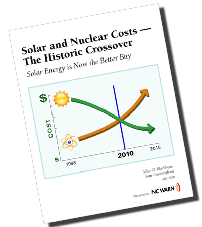New Study: Solar power is cheaper than nuclear power
 The Holy Grail of the solar industry — reaching grid parity — may no longer be a distant dream. Solar may have already reached that point, at least when compared to nuclear power, according to a new study by two researchers at Duke University.
The Holy Grail of the solar industry — reaching grid parity — may no longer be a distant dream. Solar may have already reached that point, at least when compared to nuclear power, according to a new study by two researchers at Duke University. It’s no secret that the cost of producing photovoltaic cells (PV) has been dropping for years. A PV system today costs just 50 percent of what it did in 1998. Breakthroughs in technology and manufacturing combined with an increase in demand and production have caused the price of solar power to decline steadily. At the same time, estimated costs for building new nuclear power plants have ballooned.
The result of these trends: “In the past year, the lines have crossed in North Carolina,” say study authors John Blackburn and Sam Cunningham. “Electricity from new solar installations is now cheaper than electricity from proposed new nuclear plants.”
If the data analysis is correct, the pricing would represent the “Historic Crossover” claimed in the study’s title.
Two factors not stressed in the study bolster the case for solar even more:
1) North Carolina is not a “sun-rich” state. The savings found in North Carolina are likely to be even greater for states with more sunshine –Arizona, southern California, Colorado, New Mexico, west Texas, Nevada and Utah.
2) The data include only PV-generated electricity, without factoring in what is likely the most encouraging development in solar technology: concentrating solar power (CSP). CSP promises utility scale production and solar thermal storage, making electrical generation practical for at least six hours after sunset.
Power costs are generally measured in cents per kilowatt hour – the cost of the electricity needed to illuminate a 1,000 watt light bulb (for example) for one hour. When the cost of a kilowatt hour (kWh) of solar power fell to 16 cents earlier this year, it “crossed over” the trend-line associated with nuclear power. (see chart below)

Solar-Nuclear cost comparison (from Blackburn and Cunningham)
The authors point out that some commercial scale solar developers are now offering electricity at 14 cents a kWh in North Carolina, a price which is expected to continue to drop.
While the study includes subsidies for both solar and nuclear power, it estimates that if subsidies were removed from solar power, the crossover point would be delayed by a maximum of nine years.
The report is significant not only because it shows solar to be a cheaper source of energy than nuclear. The results are also important because, despite the Senate’s failure to pass a climate and energy bill this year, taxpayers now bear the burden of putting carbon into the atmosphere through a variety of hidden charges – or externalities, as economists call them. Fossil fuels currently account for 70 percent of the electricity generated in the U.S. annually. (Nuclear generates 20 percent.)
Having dropped below nuclear power, solar power is now one of the least expensive energy sources in America.

